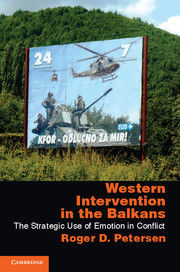Book contents
- Frontmatter
- Contents
- Acknowledgments
- Part 1 Background and Theory
- Part 2 Cases and Tests
- 7 Background to Western Intervention in the Balkans
- 8 The Case of the Roma in Kosovo
- 9 Background to Kosovo
- 10 Waiting for the West
- 11 Kosovo Intervention Games, I
- 12 Kosovo Intervention Games, II
- 13 Kosovo Conclusions
- 14 South Serbia
- 15 Macedonia
- 16 Bosnia
- 17 Montenegro
- 18 Conclusion
- Appendix A A Note on Names
- Appendix B Alternative Arguments
- References
- Index
- References
14 - South Serbia
from Part 2 - Cases and Tests
Published online by Cambridge University Press: 05 June 2012
- Frontmatter
- Contents
- Acknowledgments
- Part 1 Background and Theory
- Part 2 Cases and Tests
- 7 Background to Western Intervention in the Balkans
- 8 The Case of the Roma in Kosovo
- 9 Background to Kosovo
- 10 Waiting for the West
- 11 Kosovo Intervention Games, I
- 12 Kosovo Intervention Games, II
- 13 Kosovo Conclusions
- 14 South Serbia
- 15 Macedonia
- 16 Bosnia
- 17 Montenegro
- 18 Conclusion
- Appendix A A Note on Names
- Appendix B Alternative Arguments
- References
- Index
- References
Summary
The main highway between Belgrade and Athens runs through the Presevo Valley in South Serbia. The road cuts through three municipalities, akin to counties in the U.S. system – Presevo, Bujanovac, and Medvedja – which administratively and politically define the term “South Serbia.” The thickly wooded high hills, or low mountains, that define the valley's western side separate Serbia from Kosovo. In 1947, the Yugoslav government drew this boundary line, which would come to influence political events in the region decades later.
The three municipalities form a small area – 1,249 square kilometers, or a little less than half the land area of Rhode Island. The defining feature of the region is demographic variation across districts (see Table 14.1). According to the 2002 census, Albanians dominated the southernmost Presevo district, composing 89 percent of the population, and Serbs dominated the Medvedja district, composing 67 percent of residents, whereas Bujanovac was split among Albanians (55 percent but clustered in rural areas), Serbs (34 percent, more concentrated in the city of Bujanovac), and Roma (9 percent, also in the city).
- Type
- Chapter
- Information
- Western Intervention in the BalkansThe Strategic Use of Emotion in Conflict, pp. 203 - 221Publisher: Cambridge University PressPrint publication year: 2011

